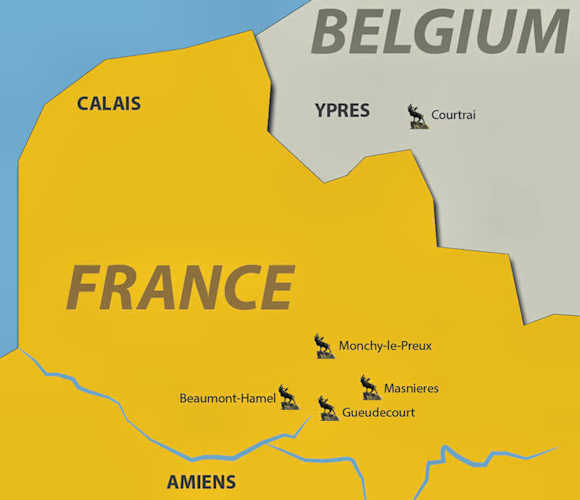Despite the great sacrifice at Beaumont Hamel on the First Day of the Somme, the Dominion continued to send fresh troops to fill the depleted ranks of the Newfoundland Regiment. At the end of July, the Newfoundland Regiment boarded trains and traveled north to the Ypres Salient in Belgium. It was here that they would spend the next three months building and fortifying trenches and taking their turn in the advance trenches, which were at points less than 30 feet from the German frontline trenches. In August the Newfoundlanders came under gas attack for the first time. The order to put on gas masks prevented any casualties.
On 8 October, after an absence of ten weeks, the Newfoundland Regiment was ordered back to the Somme to a position at Gueudecourt. The Battle of the Somme had dragged on since July and featured a series of attacks along the 16-mile German front. Orders were issued for an assault on German lines located on the outskirts of Gueudecourt. The Newfoundlanders were to advance on the right and the Essex on the left. They were given two successive objectives. To gain the first of these—the Green Line, about 400 yards from the British front line—would require the capture of a portion of Hilt Trench, with its extensions of Rainbow Trench to the southeast and Bayonet Trench to the northwest. The plans for the attack introduced a new form of tactics involving an unusually close co-operation between the advancing infantry and the supporting artillery. This became known as the creeping or rolling barrage.
 |
| Switch Trench: The Regiment's Position After the Fighting |
On 12 October, shortly after two, the order was quietly passed along: “Fix bayonets—and don’t show them over the top of the trench.” At 2:05 p.m., which was designated as Zero Hour, the attack began. At that precise minute, the artillery barrage commenced. Behind the cover of the creeping barrage, the Newfoundlanders advanced. The barrage was so heavy it prevented the Germans from using their machine guns. The Newfoundlanders were able to reach the German lines at an area designated as Hilt Trench. Fierce hand-to-hand combat ensued as the Newfoundlanders thrust with bayonet and hurled grenades into the German defenders. By 2:30 p.m., Hilt Trench was firmly occupied by the Newfoundland Regiment.
It was time now for both of Brigadier Cayley’s battalions to advance to their final objective. Keeping to the prearranged schedule, a party led by Lieutenant Cecil Clift, consisting of two platoons from each of “A” and “B” companies, pushed on toward the Brown Line. Finding no enemy trench in the first 100 yards, they began digging in under heavy fire—though not before half of them had been killed or wounded, including Clift, who was later listed as “missing, believed killed.” Caught in fire from German machine guns on their right, where the British 6th Division’s attack was only partly successful, the Newfoundlanders were forced to fall back to Hilt Trench. Some of the Essex reached Grease Trench before they too were compelled to retire to Switch Trench.
 |
| Newfoundlanders Departing the Somme in 1916 |
By late afternoon the Newfoundlanders trained their Lewis guns on the approaching enemy, inflicting heavy casualties on the advancing Germans. The Newfoundland Regiment was steadfast and held firmly to Hilt Trench. At night, the Newfoundlanders turned Hilt Trench over to reinforcements. For some, the disaster at Beaumont Hamel had been avenged, despite having suffered 239 casualties themselves.
Weary from sleeplessness and the strain and physical exertion of a long day, they filed slowly through the darkness back to Gueudecourt and down a mile of Cocoa Alley to Switch Trench just in front of Flers. It was good to find a meal and then to be able to snatch a few hours sleep before beginning the inevitable task of reorganizing.
On 27 October the regiment occupied Grease Trench, which today is the site of one of the five Caribou Memorials on the Western Front. Over the next several months the Newfoundland Regiment continued to alternate between the Front Lines and the reserve trenches along the Somme Front. Christmas 1916 was spent at the small village of Camps-en-Amienois. Those members of the regiment who had served over six months in France were granted leave in London.
 |
| Newfoundland's Caribou at Gueudecourt |
Source: St. Mihiel Trip-Wire, January 2021


No comments:
Post a Comment